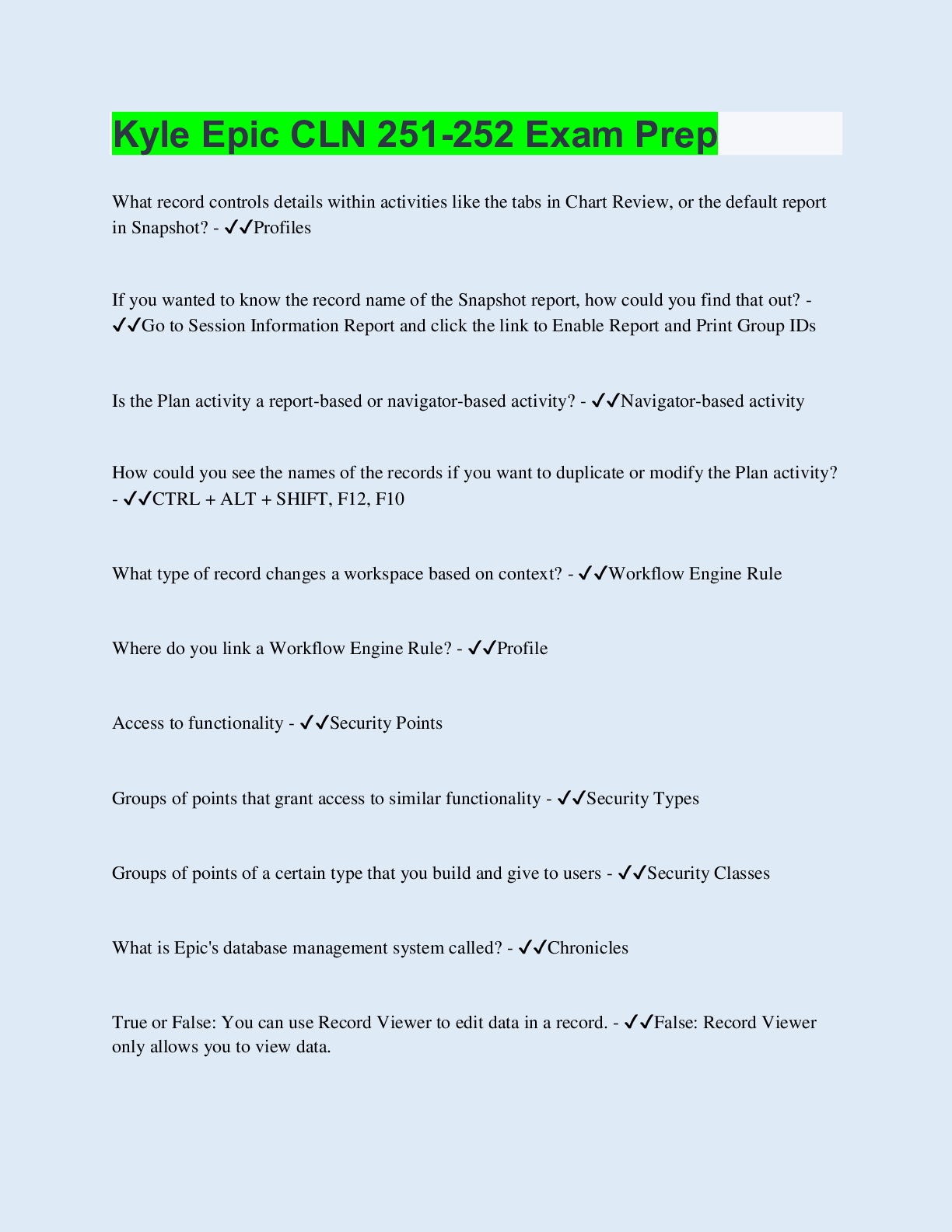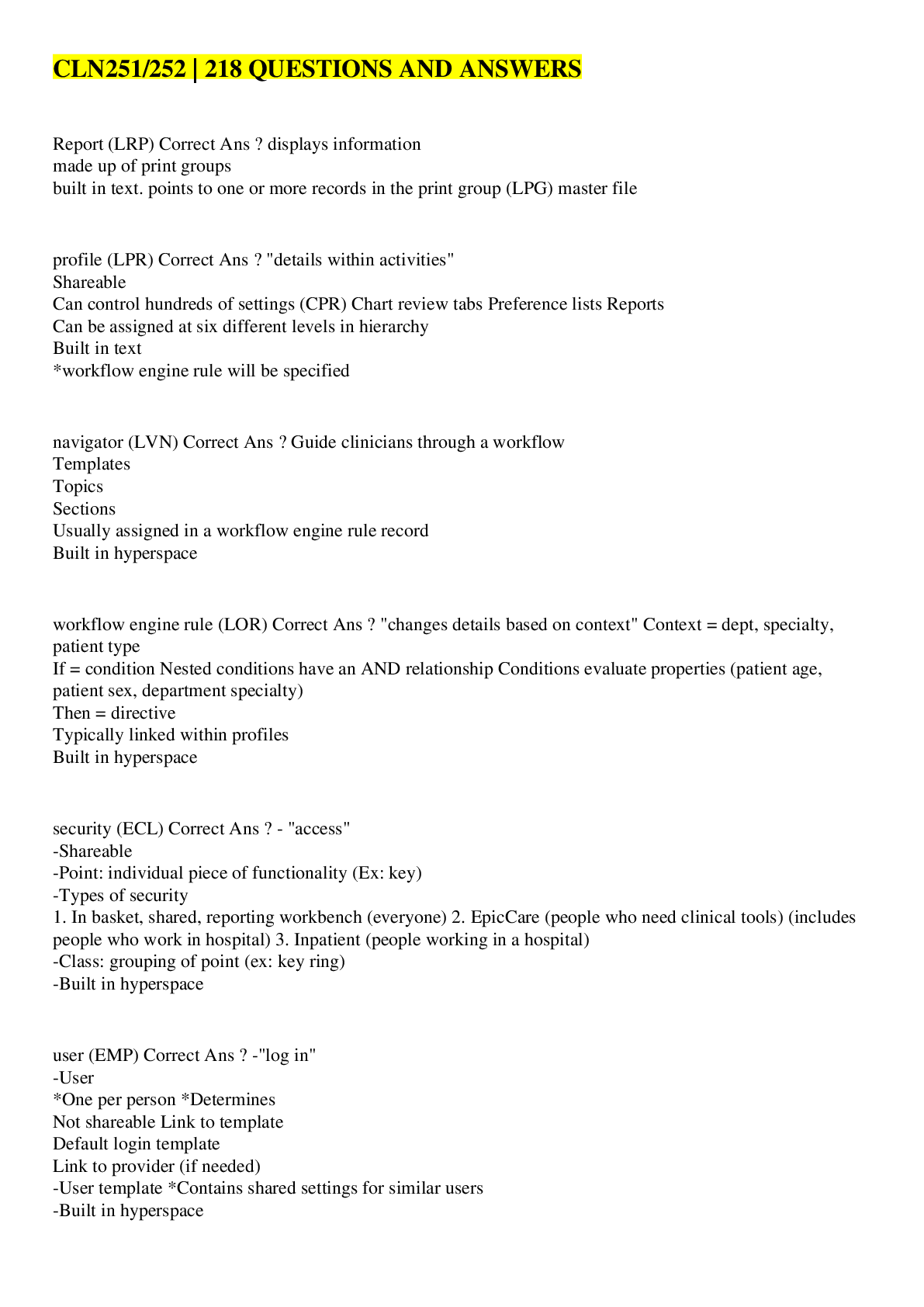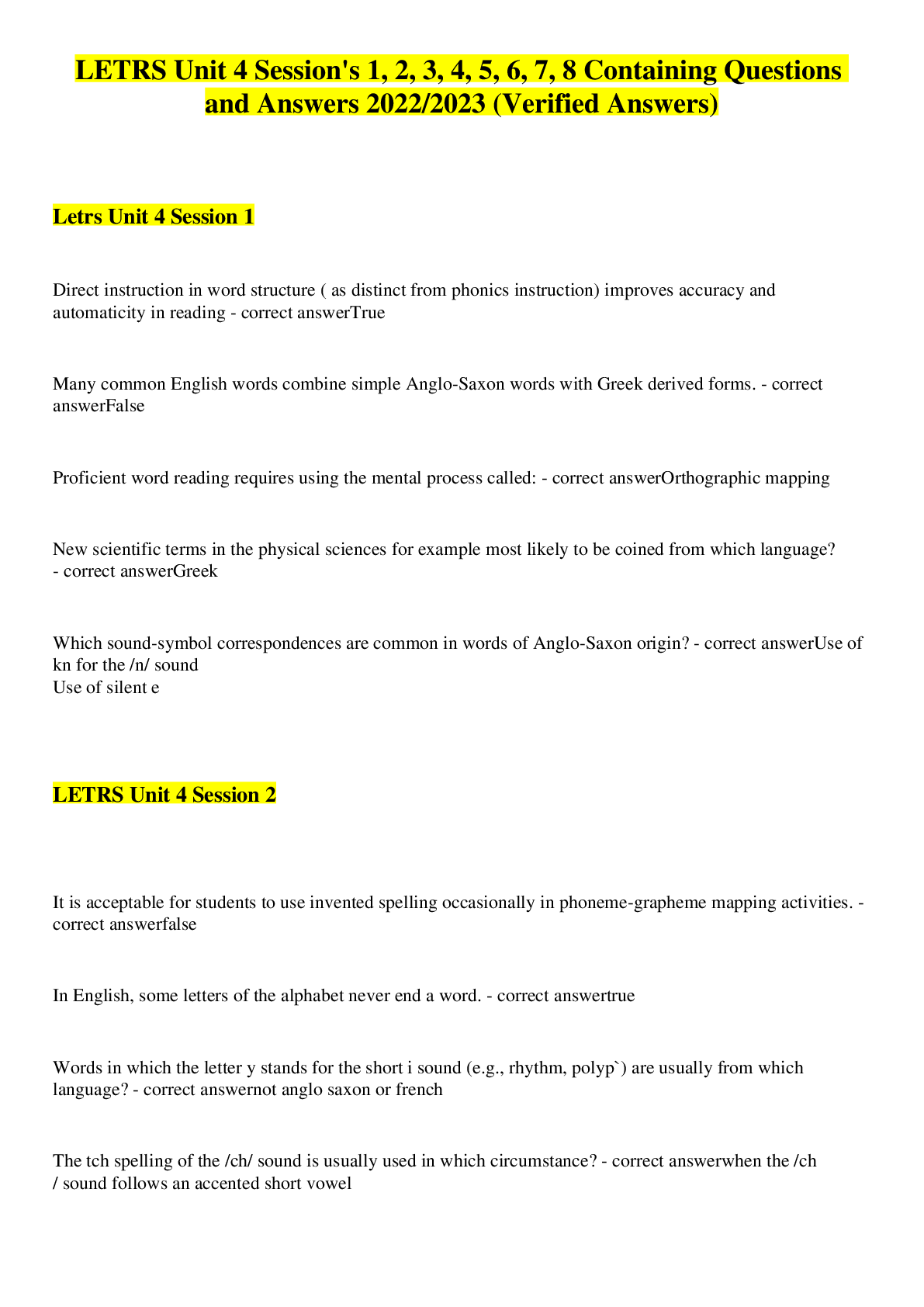*NURSING > EXAM > NUTR 100 Week 8 Final Exam (RATED A+) Questions and Answers | (Nutrition, Vitamin) | GUARANTEED PASS (All)
NUTR 100 Week 8 Final Exam (RATED A+) Questions and Answers | (Nutrition, Vitamin) | GUARANTEED PASS.
Document Content and Description Below
NUTR 100 Week 8 Final Exam-Questions and Answers Question 1 (4 points) Carbohydrates, proteins, and lipids are _______. Question 1 options: micronutrients macronutrients subnutrients classified nutrie... nts Save Question 2 (4 points) The sugars found in grains, vegetables, legumes, and fruits are _____ __. Question 2 options: carbohydrates lipids minerals amino acids Save Question 3 (4 points) The primary objective of the Dietary Guidelines for Americans is to ensure Americans _______. Question 3 options: consume less than 2,300 mg of sodium per day choose fiber-rich fruits, vegetables, and whole grains often increase intake of fats and oils high in saturated or trans fatty acids balance calorie intake with physical activity to manage weight Save Question 4 (4 points) Which of the following is the correct order of the recommended steps to prevent foodborne illness, according to the Dietary Guidelines for Americans? Question 4 options: Wash, Separate, Prepare, Store Clean, Separate, Cook, Chill Clean, Cook, Cool, Reheat Wash, Separate, Heat, Freeze Save Question 5 (4 points) The _______ estimates the nutrient intake level that will meet the needs of 50 percent of the individuals in a specific life-stage or gender group. Question 5 options: Estimated Average Requirement Recommended Dietary Allowance Tolerable Upper Limit Average Needs Level Save Question 6 (4 points) Essential nutrients are nutrients that _______. Question 6 options: can be synthesized in the body must be obtained from dietary intake are essential to good health can only be obtained through taking supplements Save Question 7 (4 points) The current icon to represent the food groups is known as _______. Question 7 options: The Food Guide Pyramid MyPlate MyPyramid Idaho Plate Method Save Question 8 (4 points) Replacing lost nutrients in foods is called _______. Question 8 options: fortification pasteurization enrichment modification Save Question 9 (4 points) The majority of digestion takes place in the _______. Question 9 options: duodenum colon jejunum ileum Save Question 10 (4 points) Celiac disease is treated by removing gluten from the diet. Gluten is found in all of the following EXCEPT _______. Question 10 options: wheat rye barley rice Save Question 11 (4 points) Lipase is an enzyme that breaks down _______. Question 11 options: carbohydrate fat protein all of these choices Save Question 12 (4 points) In order to move food from the mouth, down the esophagus, and into the stomach, the food must be made into _____. Question 12 options: chyme a bolus a blob an epiglottis Save Question 13 (4 points) A __________ fat has two or more carbon double bonds. Question 13 options: saturated bisaturated monounsaturated polyunsaturated Save Question 14 (4 points) Which of the following is not a digestion accessory organ? Question 14 options: liver gallbladder colon pancreas Save Question 15 (4 points) The AMDR for protein is______ percent of total daily calories. Question 15 options: 5 to 10 10 to 35 20 to 35 45 to 65 Save Question 16 (4 points) How many kilocalories are in 24 grams of fat? Question 16 options: 216 168 96 240 Save Question 17 (4 points) ___________ atoms are added to unsaturated fats in order to make liquid fats more solid at room temperature. Question 17 options: carbon hydrogen sodium lipid Save Question 18 (4 points) How many amino acids can’t be synthesized in the body? Question 18 options: 9 11 21 19 Save Question 19 (4 points) The AMDR for fat is _____________ percent of daily kilocalorie intake. Question 19 options: 45 to 65 5 to 10 20 to 35 10 to 35 Save Question 20 (4 points) An enzyme ___________ a chemical reaction. Question 20 options: slows down speeds up stops provides stability for Save Question 21 (4 points) Which of the following combines with carbon, hydrogen, and oxygen to make up the structure of protein? Question 21 options: nitrogen sulfur pepsin chloride Save Question 22 (4 points) A triglyceride is formed through a ____________reaction between a glycerol and _______fatty acid(s). Question 22 options: partial hydrogenation; one rehydration; three lipogenesis; one dehydration; three Save Question 23 (4 points) _______ is the deficiency associated with thiamin. Question 23 options: scurvy beriberi rickets anemia Save Question 24 (4 points) Which of the following choices include all of the fat-soluble vitamins? Question 24 options: vitamin B12, vitamin B6, vitamin C, vitamin D vitamin A, vitamin D, vitamin E, vitamin K vitamin D, vitamin K, thiamin, vitamin B6 vitamin E, vitamin A, vitamin B6, niacin Save Question 25 (4 points) B-complex vitamins often serve as _______. Question 25 options: cofactors/coenzymes blood thinners a source of calories none of these choices Save Question 26 (4 points) Flushing is a common side effect from which nutrient? Question 26 options: thiamin vitamin C niacin sodium Save Question 27 (4 points) The majority of sodium intake for the standard American diet comes from _______. Question 27 options: iodized table salt sauces and soups processed foods cheese Save Question 28 (4 points) Metabolism is described as the balance between __________ and _________ reactions in the body. Question 28 options: steroidal; carboxylic anabolic; synthetic catabolic; anabolic catabolic; amine Save Question 29 (4 points) You are able to maintain your body weight when energy expended _______ calories consumed. Question 29 options: exceed equals are less than double Save Question 30 (4 points) Which of the following daily protein intakes is recommended for endurance and strength training athletes? Question 30 options: 0.8-1.2 grams/kg body weight 0.5-0.8 grams/kg body weight 1.2-1.7 grams/kg body weight 2.0-2.5 grams/kg body weight Save Question 31 (4 points) All of the following are guidelines for reducing cancer risk EXCEPT: Question 31 options: Limit intake of charred foods. Reduce intake of red meat. Increase consumption of fruits. All of these choice are guidelines to reduce cancer risk. Save Question 32 (4 points) Research studies are often used to provide evidence for CAM therapies. Question 32 options: True False Save Question 33 (4 points) Sodium, calcium, iron, vitamin C, and vitamin A are all required by law to be included on the food label. Question 33 options: True False Save Question 34 (4 points) Peanut butter is one example of a high-quality protein. Question 34 options: True False Save Question 35 (4 points) Supplements are approved by the FDA before reaching the market. Question 35 options: True False Save Question 36 (4 points) Vitamin D is a nonessential nutrient. Question 36 options: True False Save Question 37 (4 points) Weight loss occurs when energy balance is in equilibrium. Question 37 options: True False Save Question 38 (4 points) A high-fiber, low-fat diet may reduce the risk of cancer Question 38 options: True False Save Question 39 (4 points) Body Mass Index (BMI) provides an accurate measurement of the amount of fat tissue on the body. Question 39 options: True False Save Question 40 (4 points) Before exercising, athletes are encouraged to drink plenty of fluids and consume a high-fat meal for energy. Question 40 options: True False Save Question 41 (20 points) Describe two common dietary misconceptions in our society today. Write a 200 word essay (with at least 2 references) refuting the misconceptions and using information that you have learned in this class. Question 41 options: There are a lot of dietary misconceptions in our society today. The only way to changes these misunderstandings is to debunk them. Two of the most common myths are all fats are bad and to avoid carbohydrates to lose weight. All fats are not bad. Per UW Medicine, “Everyone needs fat, and it aids in nutrient absorption, nerve transmission and maintenance of cell membranes. Fats are not created equal. Some fats promote good health while others increase the risk for heart disease.” (2017) Polyunsaturated and monounsaturated fats such as olive oil and avocados are good fats. In many cases, low or fat free foods are worse for you with the additives to improve taste. (National Institute of Diabetes and Digestive and Kidney Diseases, 2014) Avoiding carbohydrates do not help in weight-loss is another major myth. “Carbohydrates do not cause weight gain. The truth is that most low carb diets are also calorie restricted… The initial weight loss seen in these diets is caused by the body burning stored carbohydrates for energy, which releases water so the loss is only a water shift and not an actual weight loss.” (National Institute of Diabetes and Digestive and Kidney Diseases, 2014) Keeping hydrated is important when dieting and exercising. Starving your body of carbohydrates that contain essential vitamins is not healthy. Eating right, cutting calories, and exercise is the right way to go. References: National Institute of Diabetes and Digestive and Kidney Diseases. 2014. Weight=loss and Nutrition Myths. Retrieved From: UV Medicine. 2017. Diet and Nutrition Myths. Retrieved From: Save Question 42 (20 points) Your friend insists that it is impossible to survive long-term on a vegetarian diet (vegan). Describe to your friend how a vegan diet can also be a "healthy diet" . Create a one day eating plan (3 meals, 2 snacks), for a 30 year old woman of an average BMI that is an athlete (wrestler). Question 42 options: Vegan diets are quite easily managed. “Vegetarian diets have a number of benefits. Well-balanced eating plans can lower the risk of a number of chronic conditions, including heart disease, diabetes, and obesity. They also help to promote sustainable agriculture.” (Zimmerman & Snow, 2012) There are several ways to reach each of the dietary needs of an athlete on this diet. Below is a meal plan for only one day. It shows how much diversity there can be in just one day and it is easily adjustable to accommodate any type lifestyle. References: Zimmerman and Snow. 2012. An Introduction to Nutrition (v. 1.0) Retrieved From: VEGAN MEAL PLAN Based on an athlete diet- Start the morning off right with a glass of water Wake Up: Water 8oz Breakfast: Oatmeal with orange juice and coffee Water 8oz whole grain oatmeal 1 cup almond milk 8oz (to make with the oatmeal) calcium fortified orange juice 8oz coffee 8oz with ¼ cup of Almond milk cashews Snack: Fruit and veggies with Peanut butter Water 8oz Peanut Butter 2 Tbsp Apple 1 medium Celery 2 medium stalks Before Lunch: Water 8oz Lunch: Spinach salad with veggie burger patty drizzled with balsamic Water 8oz Veggie Burger balsamic vinegar 2Tbsp spinach 2 cup kale quinoa Snack: tomato slices sprinkled with cheese and balsamic Water 8oz tomato 1 medium balsamic vinegar 1 Tbsp vegetarian cheese (Go Vegan Mozzarella) ¼ cup basil 2 Tbsp Before Dinner Water 8 oz Dinner: brown rice cooked with coconut milk with sautéed tofu, broccoli, and almonds on top. Water 8oz broccoli 2 cups almonds ¼ cup brown rice 1 cup tofu ½ cup cubed seasoning/spices coconut milk for cooking with ½ cup After Dinner Water 8 oz [Show More]
Last updated: 1 year ago
Preview 1 out of 20 pages
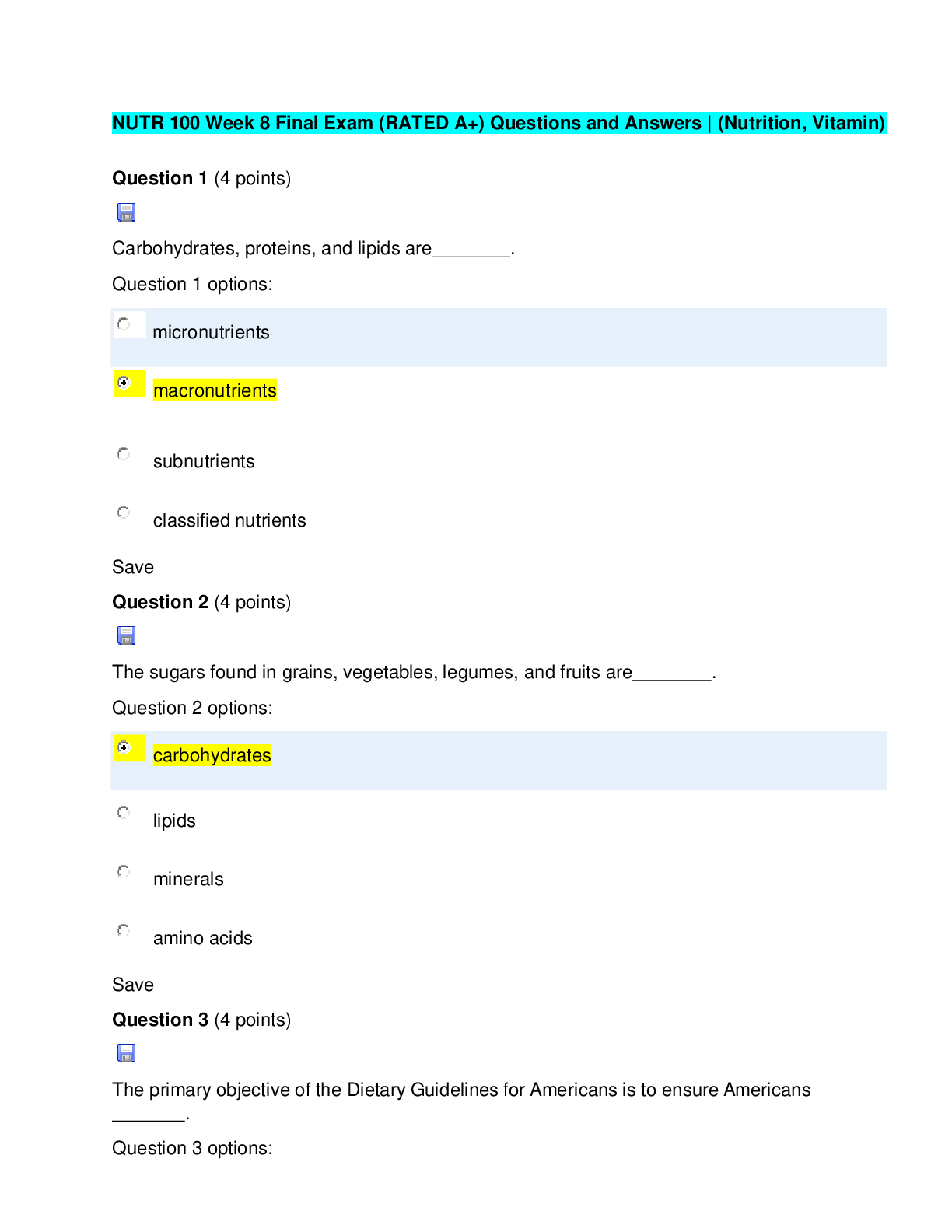
Reviews( 0 )
Document information
Connected school, study & course
About the document
Uploaded On
Aug 18, 2021
Number of pages
20
Written in
Additional information
This document has been written for:
Uploaded
Aug 18, 2021
Downloads
0
Views
38




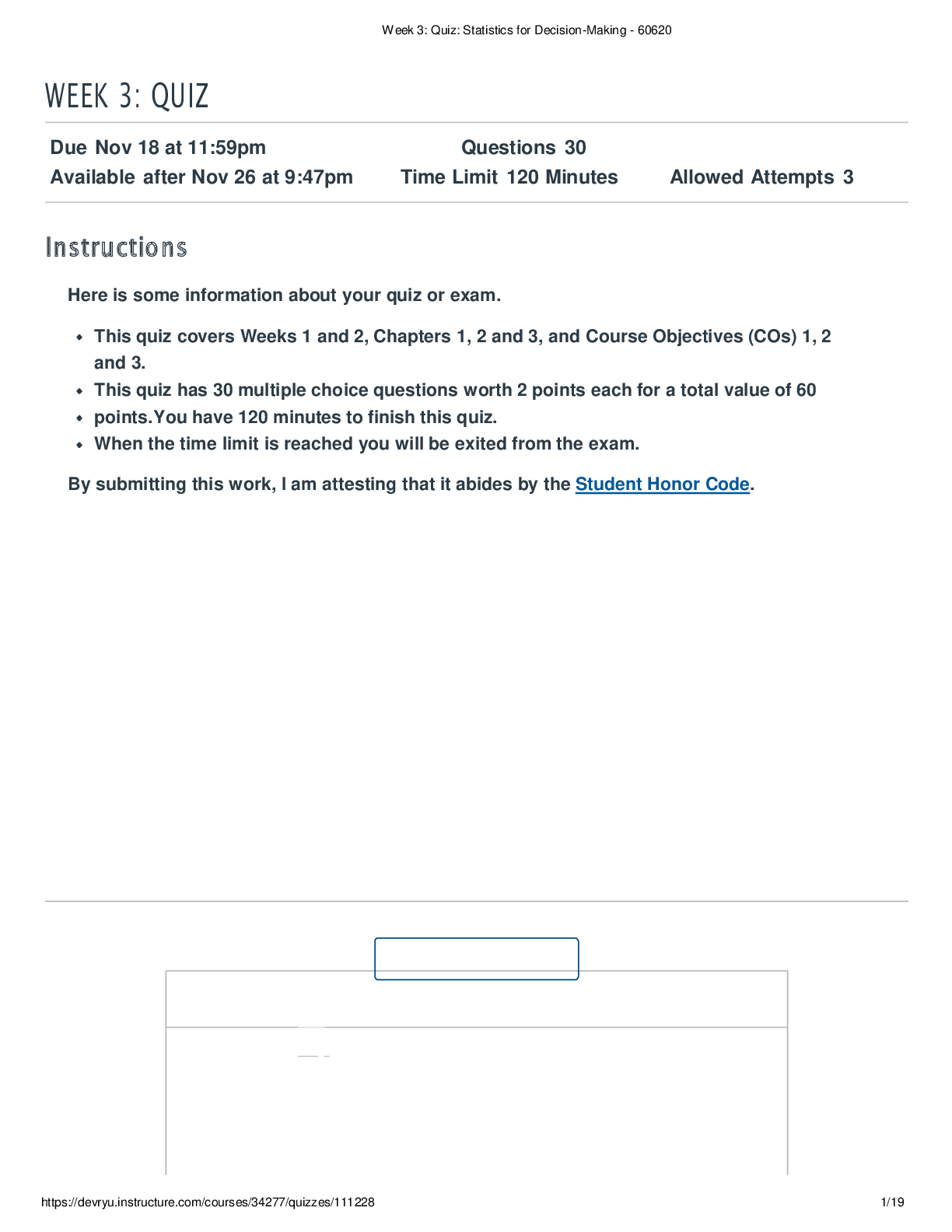

.png)













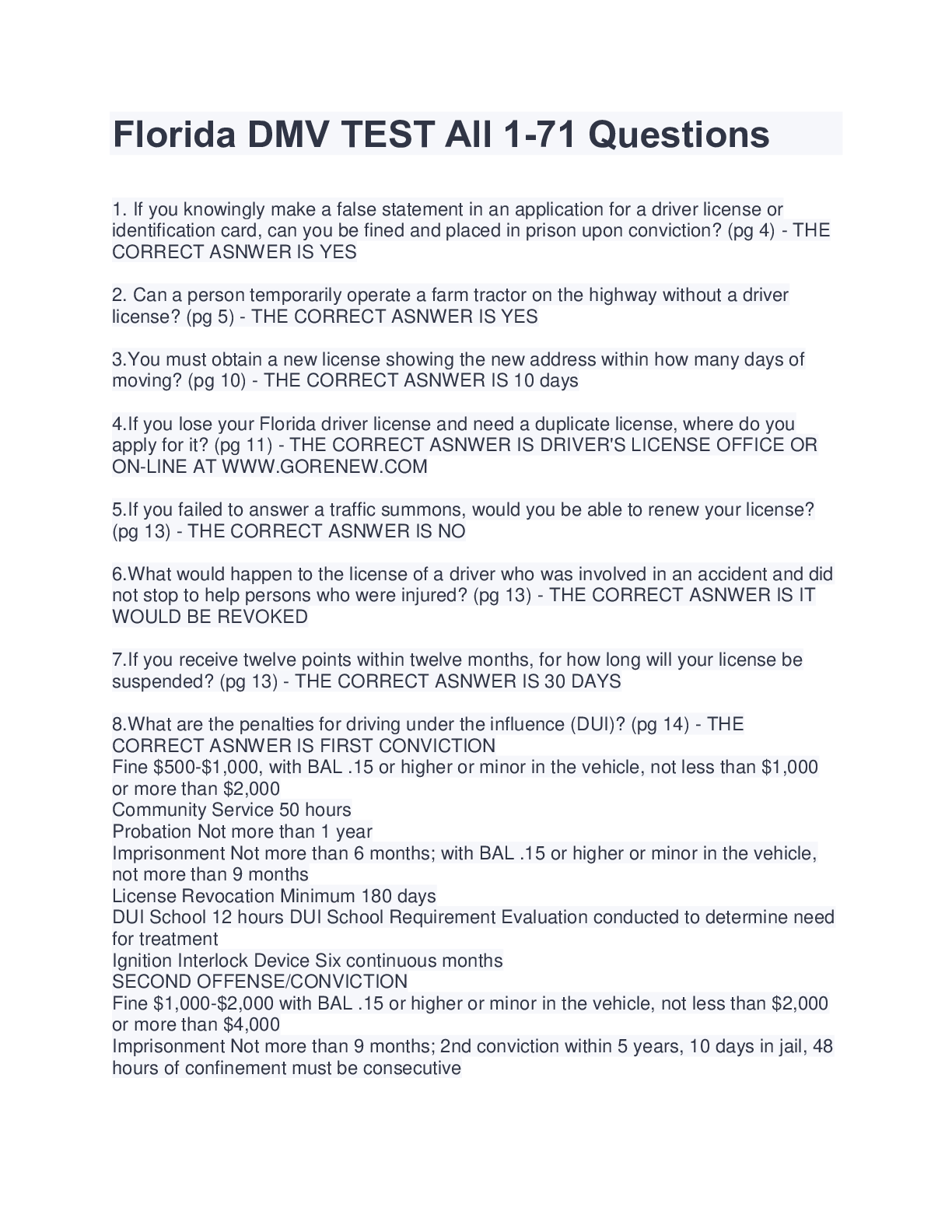
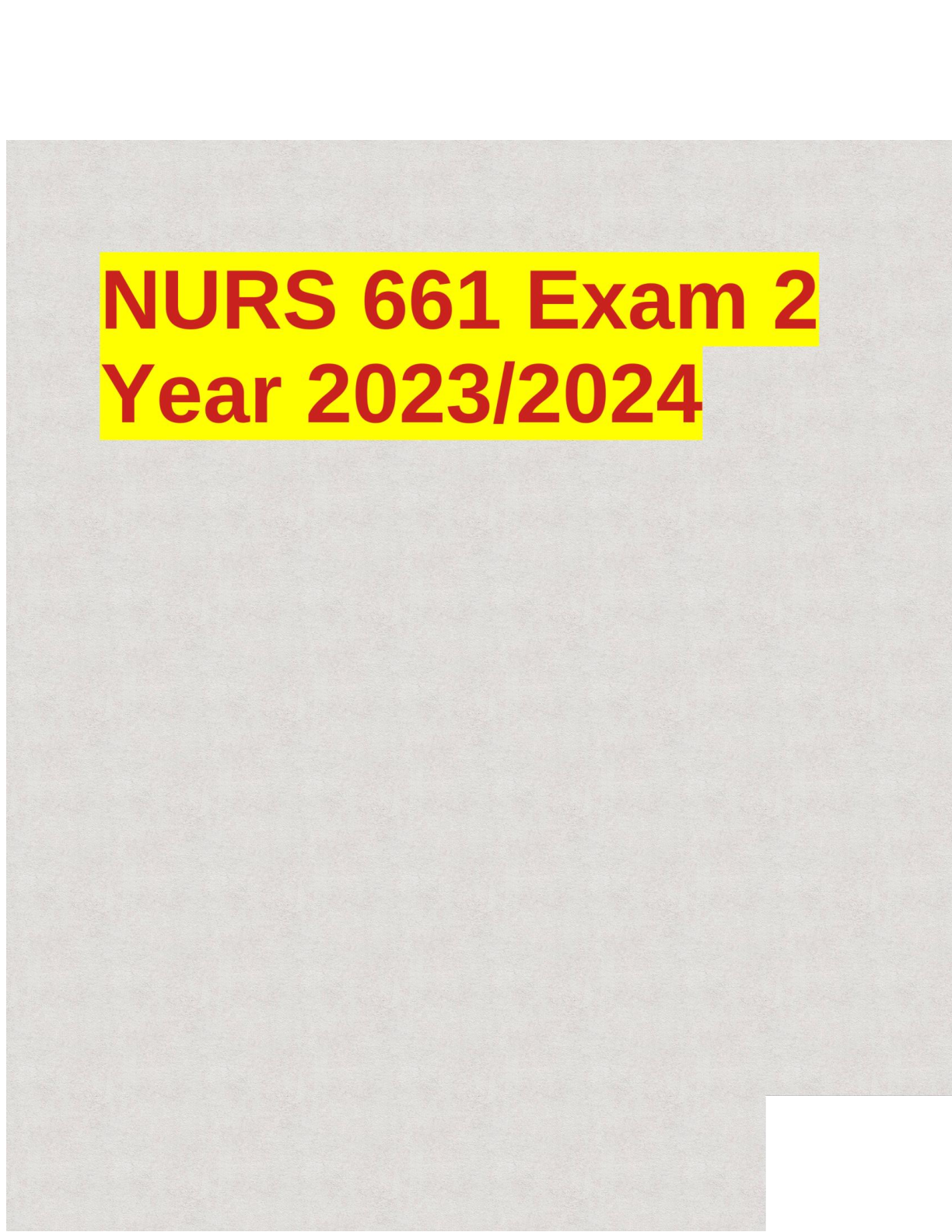

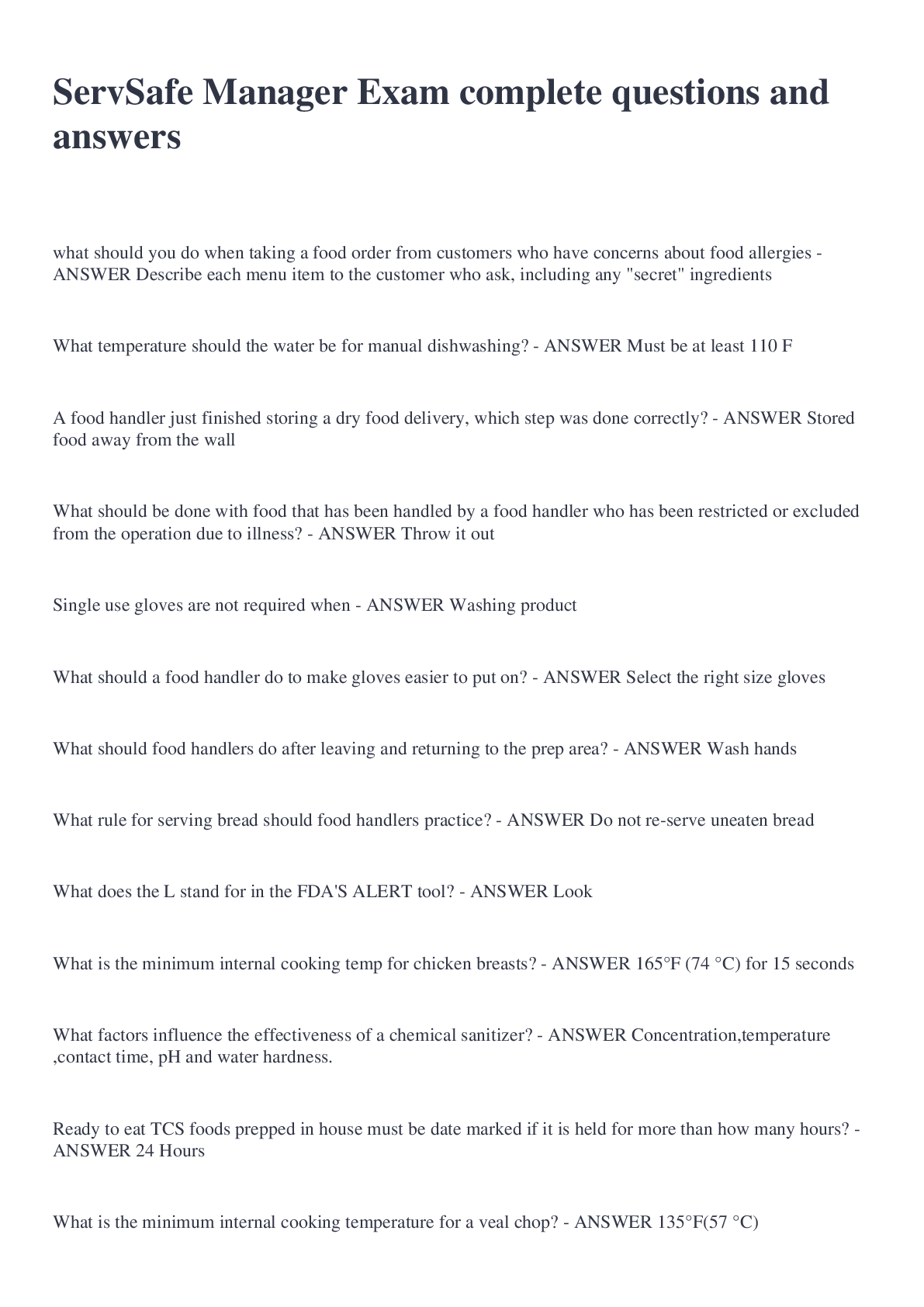

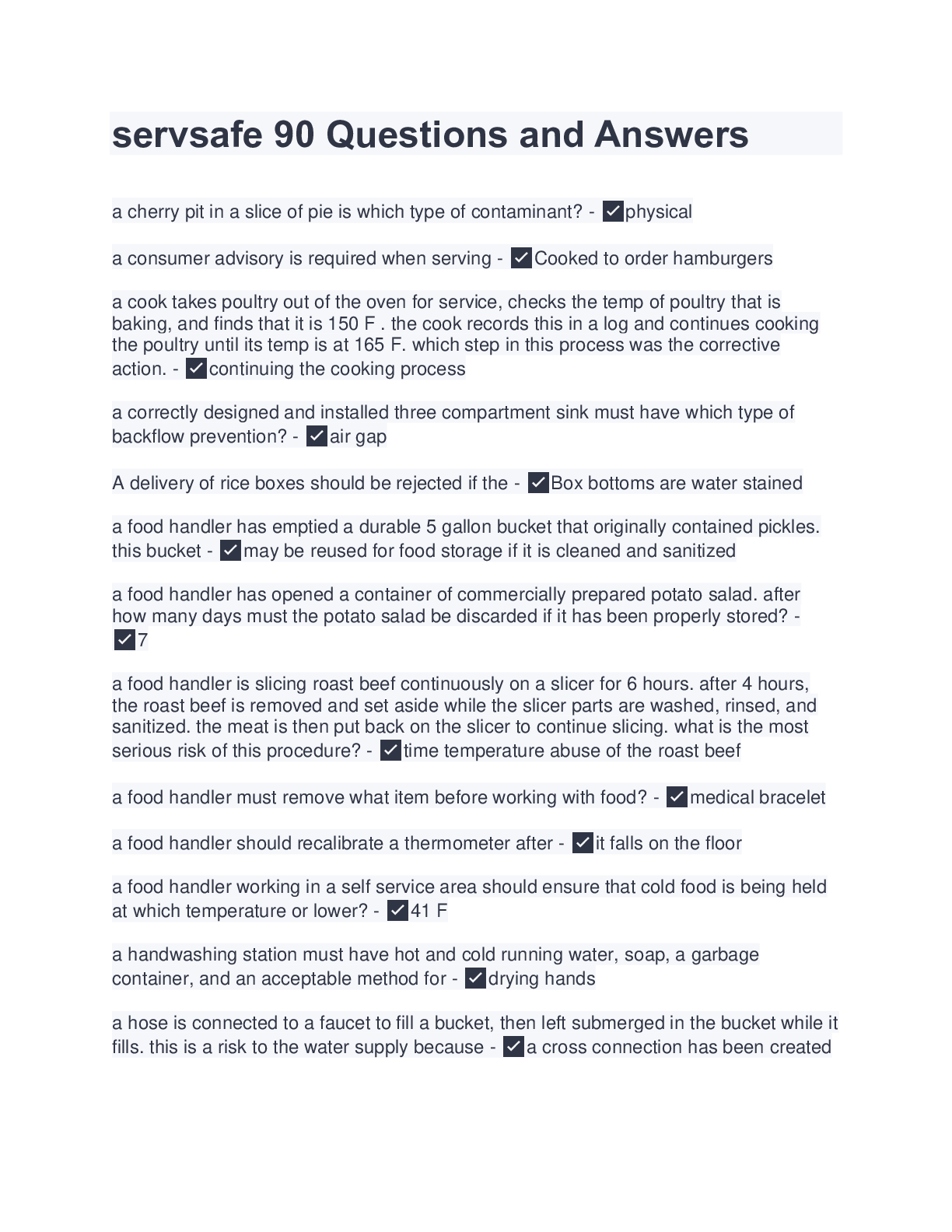
.png)


